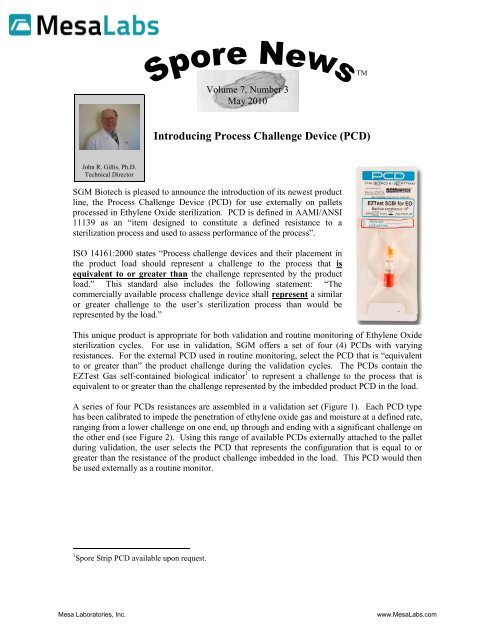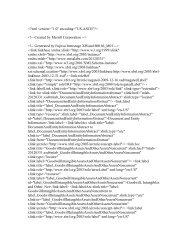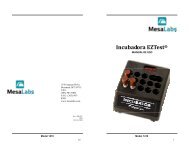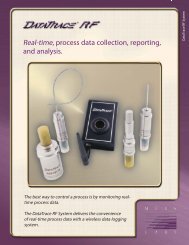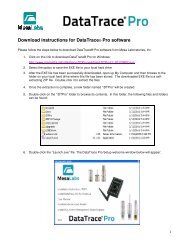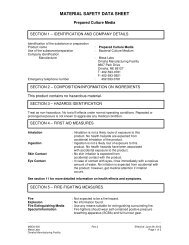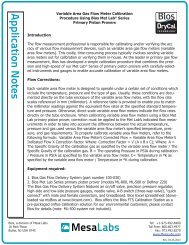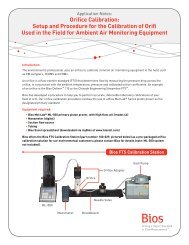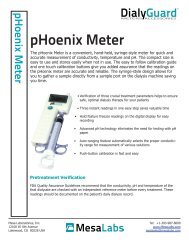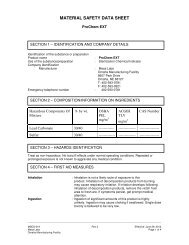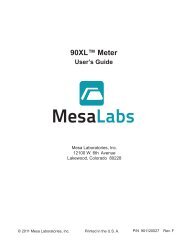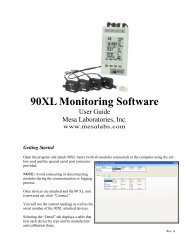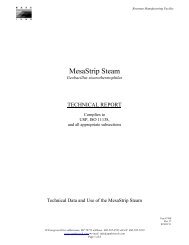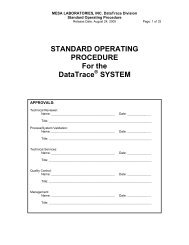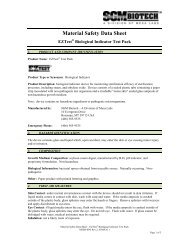V7 N3 John Introducing PCD - Mesa Labs
V7 N3 John Introducing PCD - Mesa Labs
V7 N3 John Introducing PCD - Mesa Labs
- No tags were found...
Create successful ePaper yourself
Turn your PDF publications into a flip-book with our unique Google optimized e-Paper software.
TMVolume 7, Number 3May 2010<strong>Introducing</strong> Process Challenge Device (<strong>PCD</strong>)<strong>John</strong> R. Gillis, Ph.D.Technical DirectorSGM Biotech is pleased to announce the introduction of its newest productline, the Process Challenge Device (<strong>PCD</strong>) for use externally on palletsprocessed in Ethylene Oxide sterilization. <strong>PCD</strong> is defined in AAMI/ANSI11139 as an “item designed to constitute a defined resistance to asterilization process and used to assess performance of the process”.ISO 14161:2000 states “Process challenge devices and their placement inthe product load should represent a challenge to the process that isequivalent to or greater than the challenge represented by the productload.” This standard also includes the following statement: “Thecommercially available process challenge device shall represent a similaror greater challenge to the user’s sterilization process than would berepresented by the load.”This unique product is appropriate for both validation and routine monitoring of Ethylene Oxidesterilization cycles. For use in validation, SGM offers a set of four (4) <strong>PCD</strong>s with varyingresistances. For the external <strong>PCD</strong> used in routine monitoring, select the <strong>PCD</strong> that is “equivalentto or greater than” the product challenge during the validation cycles. The <strong>PCD</strong>s contain theEZTest Gas self-contained biological indicator 1 to represent a challenge to the process that isequivalent to or greater than the challenge represented by the imbedded product <strong>PCD</strong> in the load.A series of four <strong>PCD</strong>s resistances are assembled in a validation set (Figure 1). Each <strong>PCD</strong> typehas been calibrated to impede the penetration of ethylene oxide gas and moisture at a defined rate,ranging from a lower challenge on one end, up through and ending with a significant challenge onthe other end (see Figure 2). Using this range of available <strong>PCD</strong>s externally attached to the palletduring validation, the user selects the <strong>PCD</strong> that represents the configuration that is equal to orgreater than the resistance of the product challenge imbedded in the load. This <strong>PCD</strong> would thenbe used externally as a routine monitor.1 Spore Strip <strong>PCD</strong> available upon request.<strong>Mesa</strong> Laboratories, Inc.www.<strong>Mesa</strong><strong>Labs</strong>.com
Log 10 of PopulationFigure 1Figure 2 below illustrates a typical survivor curve of BIs in the <strong>PCD</strong>s exposed in an ethyleneoxide resistometer. The black curve on the far left represents a “naked” BI, while the remainingfour curves represent the same BI packaged in each of the four different <strong>PCD</strong> resistance types.The actual biological indicator lethality values appear in Tables I and II.7Figure 2Survivor Curve of BIs, Naked and in Four <strong>PCD</strong> types Exposed in anEthylene <strong>PCD</strong> Oxide Survivor Resistometer Curve6543<strong>PCD</strong> type 2<strong>PCD</strong> type 4<strong>PCD</strong> type 6<strong>PCD</strong> type7Naked BI2.13 (G-161)4.13 (G-160)6.13 (G-160)7.13 (G-160)G-160 Naked2100 25 50 75 100 125 150 175 200 225 250 275 300 325Time (Minutes)<strong>Mesa</strong> Laboratories, Inc.www.<strong>Mesa</strong><strong>Labs</strong>.com


